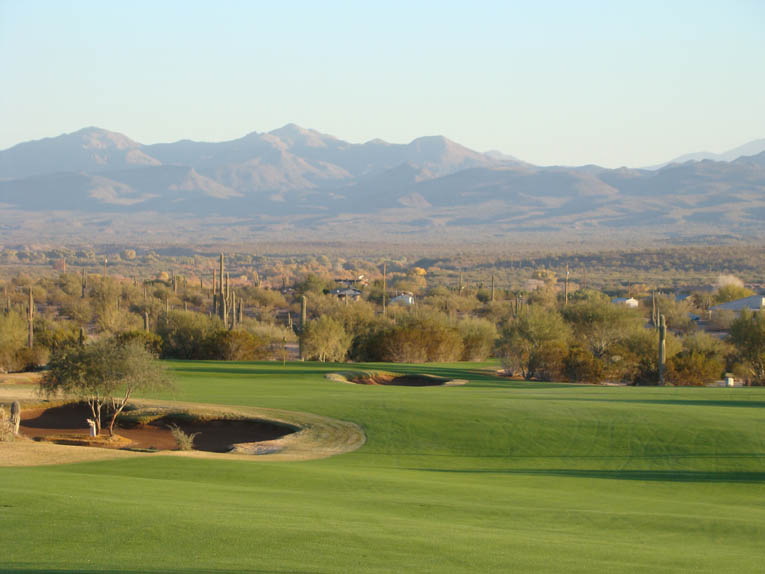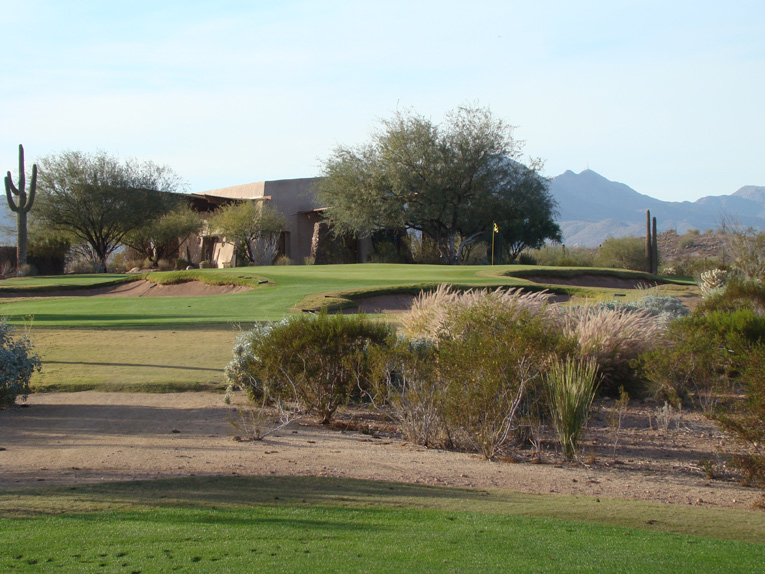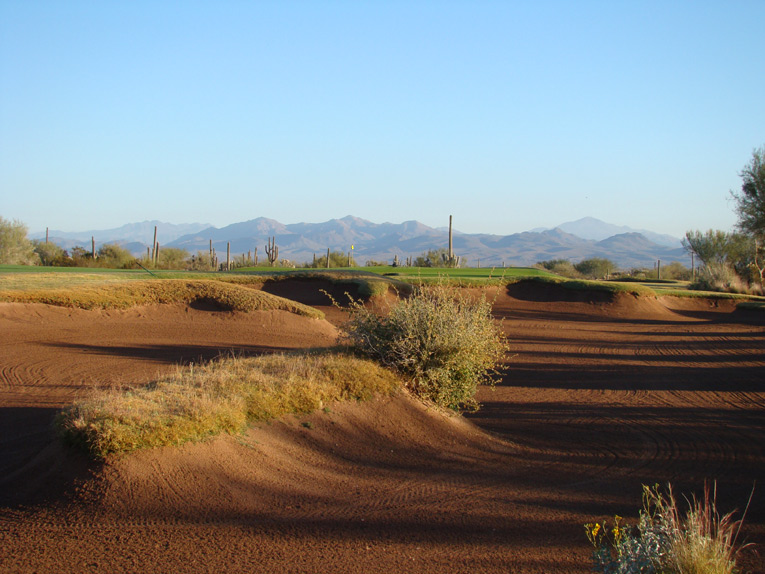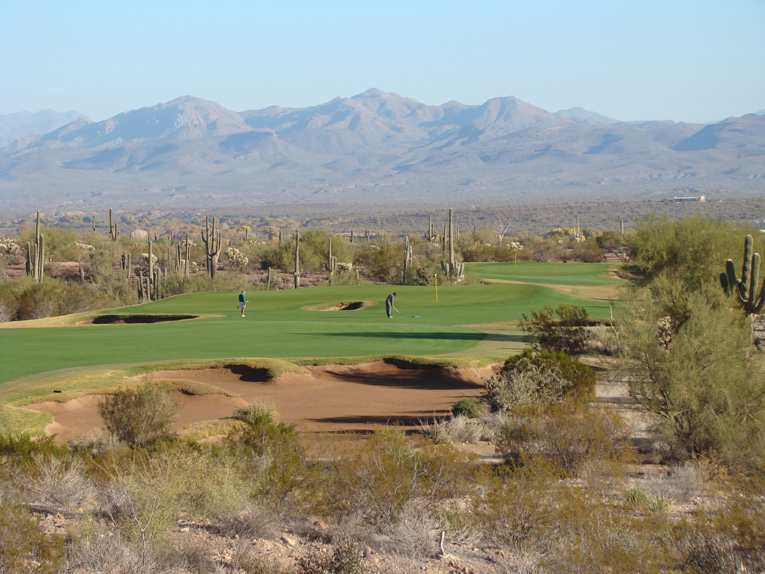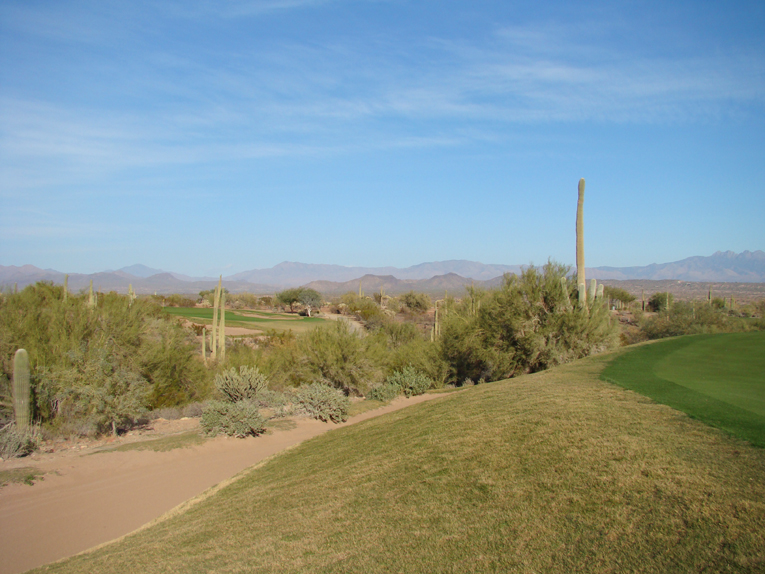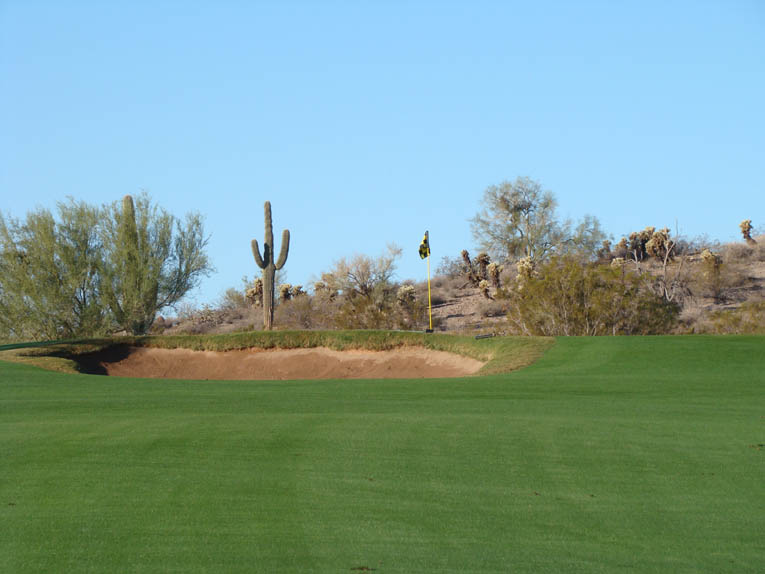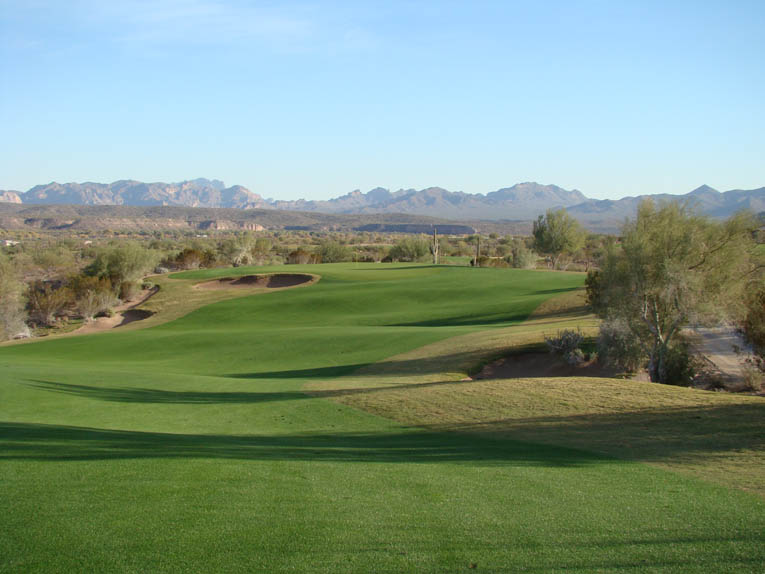We-Ko-Pa Golf Club (Saguaro Course)
Arizona, United States of America
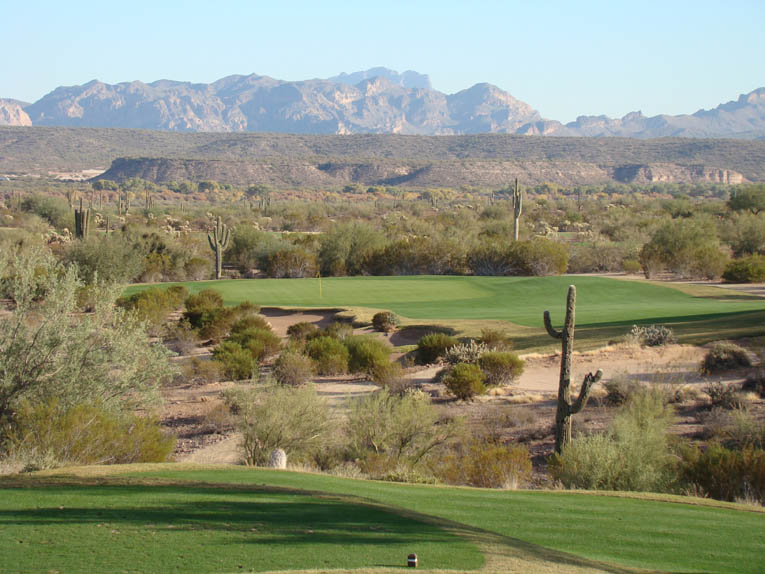
The Sagauro Course at We-Ko-Pa offers the best of both worlds: Traditional, walking friendly golf found in a captivating desert setting free of outside disturbances. Above is a view from the 255 yard fifteenth tee with the Verde River and Superstition Mountains in the background.
How does one follow a highly successful golf course?
Scott Miller, a Jack Nicklaus protégé, built the Cholla Course at We-Ko-Pa in 2001 on land owned by the Yavapai Indians of Fort McDowell. From the onset it was a success, ranked among the top 25 resort courses in the United States by the Wall Street Journal, and tee times were scarce as the surrounding resorts and casino provided an unending flow of golfers.
Over 7,200 yards long, Cholla was a big course in every respect and occupied nearly 250 acres. Still, the Yavapai had set aside an 800 acre (!) envelope of land in the beautiful Sonoran desert and intended it only for golf. Clearly, a second course made sense for the We-Ko-Pa Golf Club. Yet, who would build it? Should they hire Miller again?
Those were the questions facing the Tribal Council and Ed Francese in 2005. Francese, as the Saguaro project manager and head of the managing entity for We-Ko-Pa Golf Club, thought that visitors would appreciate variety. To that end, he decided to interview other architects and eventually narrowed the choice to two golf architectural firms known for minimal land disturbance, namely Tom Doak’s Renaissance Design and Coore & Crenshaw. Among modern architects, these two firms have built the most courses ranked in the world top 100 by GOLF Magazine.
Ultimately, the decision became rather straightforward. Renaissance’s Jim Urbina visited the site but the timing was awkward as they had three projects afoot. On the other hand, Bill Coore and his wife lived only forty minutes away, a sure sign that he appreciated the Sonoran desert and understood this part of the world. Plus, Coore made it clear that he saw great potential, noting: ‘The land had very appealing movement throughout and we couldn’t have hoped for more than what we were given.’ As they had done at nearby Talking Stick, he was confident that their design would provide something calm and soothing to the senses even though the golf would be laid across a hostile desert environment. Their creation would be his and Ben’s interpretation of ‘interesting golf’ in the desert.
The Tribal Council accepted Francese’s recommendation to employ Coore & Crenshaw. Bill Coore then did what he does best: Wander alone day after day among the nearly four hundred acres that were at his disposal. After a month, Francese began to notice more and more colored ribbons scattered about the site. In this day when architects have so much technology at their disposal one might presume this the work of vandals instead of low-tech Bill Coore!
Any property offers countless permutations and after sixty days of ambling about, Bill Coore and Ben Crenshaw produced three routings for Francese and the Tribal Nation to consider. Off they went to walk them, discussing the pros and cons of each. Ultimately, they picked today’s routing because of its set of par threes. They each liked how the four holes headed in different directions and thought that collectively they were the most varied.
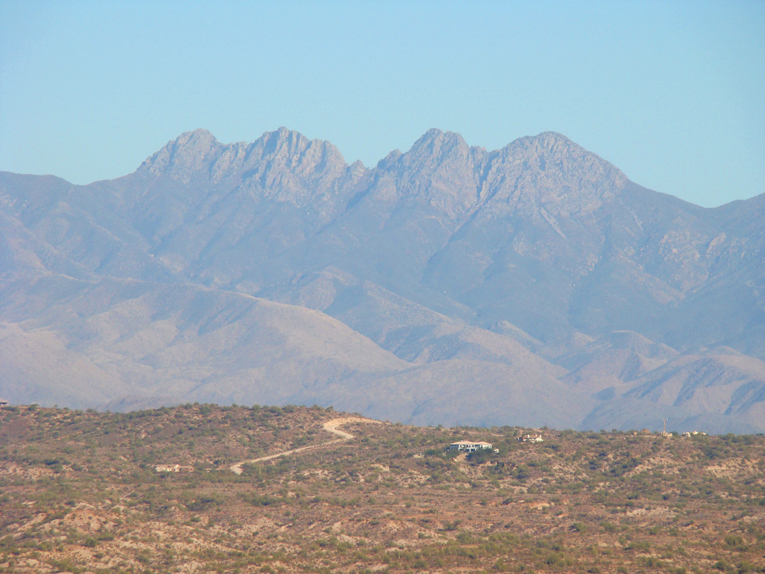
We-Ko-Pa stands for Four Peaks. This sacred mountain is seen throughout one’s round though it is 20 miles away.
Coore & Crenshaw’s talented crew descended on the project and clearing began in November 2005. Dave Axland made several early site visits and Dave Zinkand arrived shortly after the project started to serve as the on-site job superintendent until the grassing began. Jimbo Wright and Jim Craig did much of the shaping (primarily the green complexes) and Jeff Bradley did all the bunker work. Bill’s long time friend and fellow architect Rod Whitman from Canada finished the majority of the tee boxes. Marvin Mills designed and field staked all irrigation and Landscapes Unlimited had the construction contract for about 80% of the job. Clay Featherby was their superintendent on site. The Saguaro Course’s Green Keeper Ryan Kreizenbeck and a couple of his crew members assisted in the clearing. Kreizenbeck and Francese had the responsibility for installing and completing all desert re-vegetation, grassing and grow-in.
The Saguaro Course opened for play December 14th 2006 and Francese got what he wanted: A layout that would compliment the original and provide golfers with an appealing yet different option. The Miller course because it was largely routed up and down drainage required elevated fairways and over 600,000 cubic yards of earth movement. It features some spectacular elements but requires a golf cart to get around. Conversely, the Coore & Crenshaw moved only 42,000 cubic yards of dirt so that many fairways bleed into the desert floor. Their holes in general are routed cross drain. Best yet, the Coore & Crenshaw was eminently walkable.
During the routing process, Coore kept exploring a canyon behind what became the sixteenth green. The deeper he ventured, the more severe the land became. Though it offered drama that comes with elevation change, Coore ultimately rejected this portion of the property because it would render walking the course impractical. As is their want, Coore & Crenshaw delivered a traditional approach to golf even though the setting was the high desert.
The Saguaro Course measures 6,966 yards. In a welcome show of common sense, Coore & Crenshaw refrained from building a set of tees beyond 7,000 yards. Why create markers that so few would play?! As it is, a healthy 20% of players avail themselves of the ‘tips’ but an even greater percentage of customers play from the 6,603 yard set, so those are the yardages noted below.
Holes to Note
First hole, 445 yards; Theory has it that a first hole should be a reflection of what the golfer will see the rest of the round. Yet, if every designer followed set ‘rules’, how boring golf would be! Yes, the grassed tee areas are free form and flow downhill from one set to the next. Yes, this hole has a broad ninety yard (!) wide corridor of maintained grass from side to side. Yes, the green is only bunkered on one side with short grass on the other. In those three important regards, the first is like many other holes at We-Ko-Pa. However, in one important element, the first hole is quite different because a twenty yard wide wash crosses the fairway eighty yards short of the green. Every other hole offers uninterrupted short grass from the start of the fairway through the green, which is in sharp contrast to most desert courses. Coore & Crenshaw have long loathed forced carries except from a tee where every golfer is guaranteed a perfect lie and stance. Forced carries into greens require skills that many golfers lack and limit those that can enjoy the challenge so Coore & Crenshaw meticulously avoid them. This hole is the sole exception – and the course is all the better for the variety that it adds. Coore & Crenshaw would have preferred that the wash not come at the opener but they were also convinced that this configuration represented the best flow of holes.
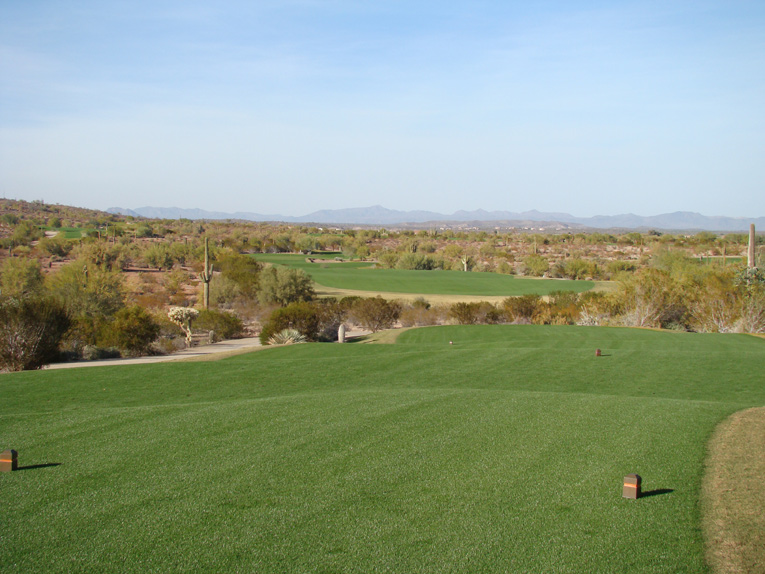
Unusual for the desert, note how the tee grounds roll down. This recurs at other elevated tees including the second, eighth, tenth, eleventh, fourteenth, fifteenth, seventeenth, and eighteenth.
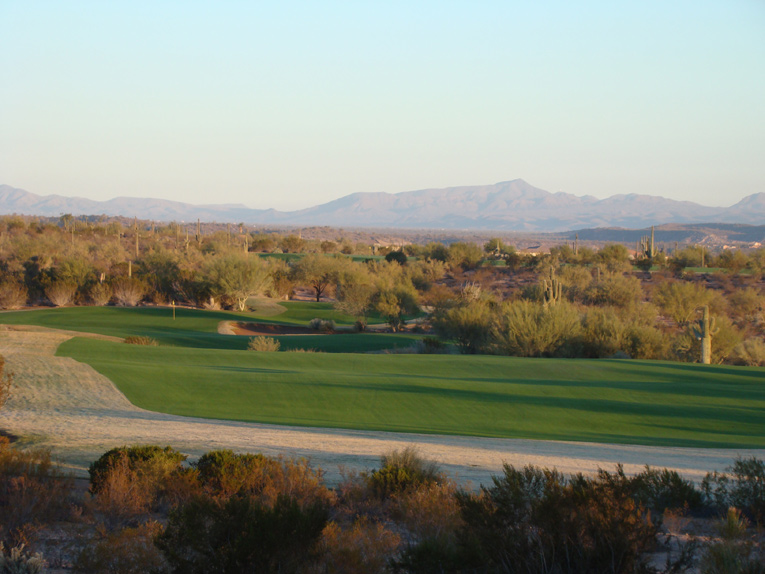
As seen in an early morning December light, the first fairway is vast, measuring over seventy yards from side to side. There is no reason to miss it which is good because …
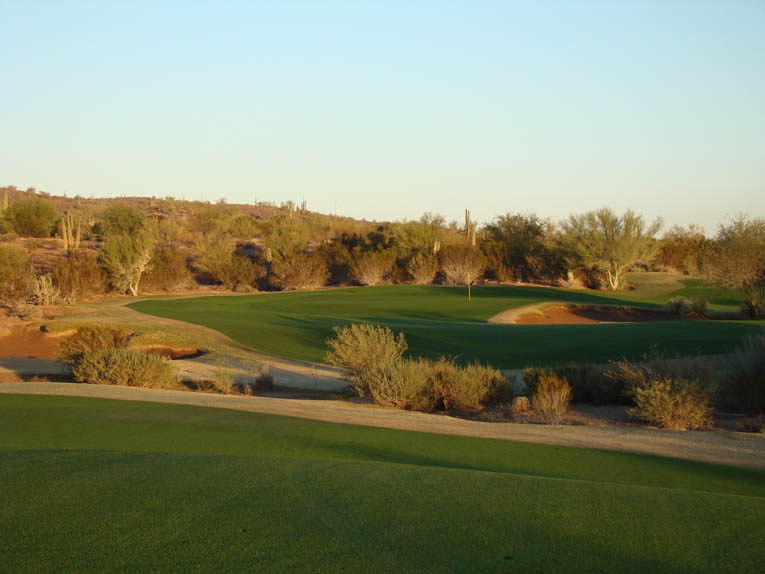
… one’s second shot needs to carry this wash. The green complex beyond features a hazard on one side and short grass on the other. However, don’t be fooled into thinking that left represents the easier up and down. As frequently found at Royal Melbourne, the putting surface tilts toward the hazard, making recoveries from the short grass more ticklish than one initially suspects.
Second hole, 300 yards; The Saguaro Course features more short two shot holes (here, the seventh, tenth and sixteenth) than any other Coore & Crenshaw design with which the author is familiar. Evenly spread throughout the round, they each measure under 340 yards from the back markers and pose a remarkably different challenge. The second is routed sidehill, the seventh features a blind drive up a hill where central hazards await, the tenth is downhill with everything in sight, and the sixteenth features the sharpest climb on the course.
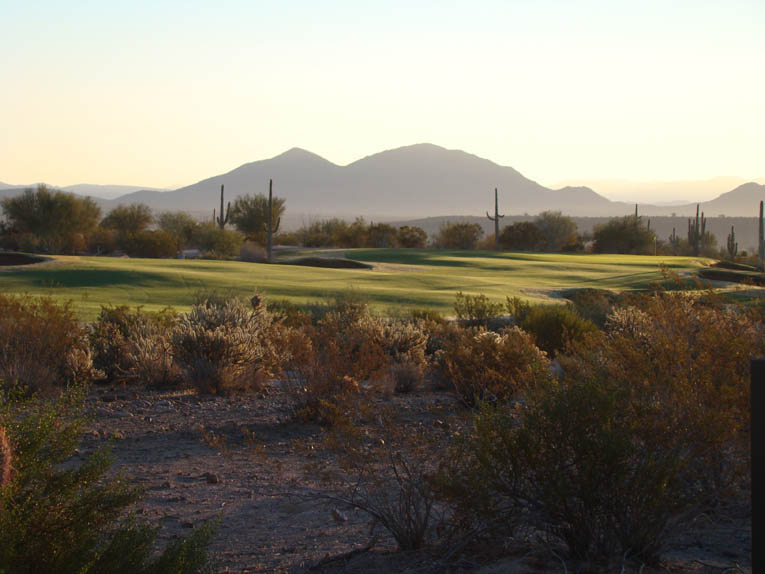
Routed sidehill, the second fairway is full of little ripples and small undulations of the sort that require the golfer to make slight adjustments to his stance/set-up. Such minor random movement is ideal for golf and is only achieved when man’s hand is soft upon the land. Ahead, Coore & Crenshaw created a particularly fine deep green by proping up the back half. Minimalism doesn’t mean moving minimal dirt – it means moving it in a manner that is indiscernible to the eye while creating good golf. This green exemplifies the merit of that philosophy.
Fourth hole, 610 yards; This hole features a central hazard, something that the author has always thought was wanting at another famous 600 yard hole, the fifteenth at Pine Valley. At Saguaro, it punctuates the fairway 235 yards from the tee and without it, the tee shot to the wide flat fairway would lack interest. Ahead, the fairway tumbles downhill and pivots left around a handsome bunker. The ideal play is to hug this bunker for the sake of gaining the optimal angle into the green. Not immediately evident from the fairway is the sharp embankment left of the green that leaves pulled shots lifeless on the inhospitable desert floor below.
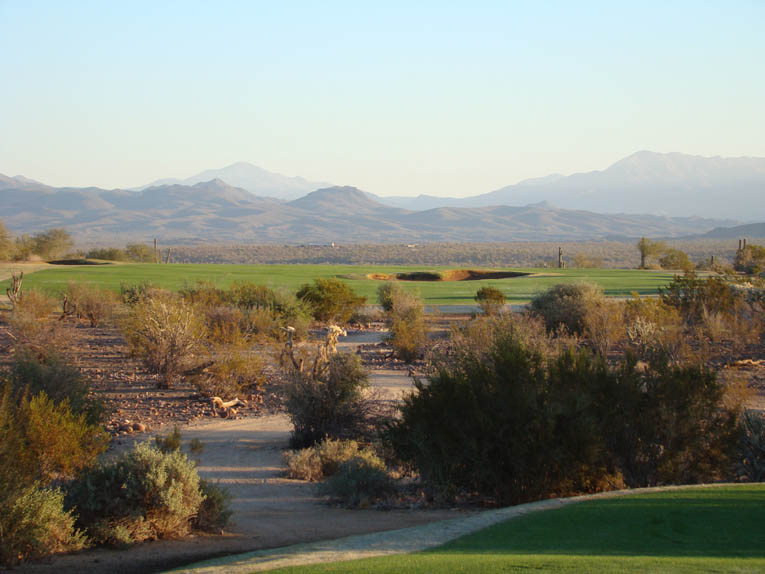
A lengthy three shotter, the golfer does himself a favor by taking the short way home by squeezing his drive between the bunker left and central hazard right.
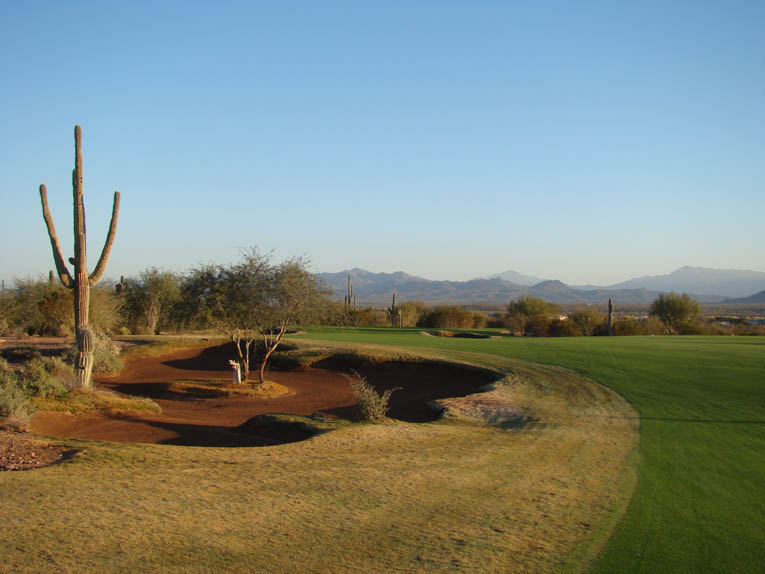
… a formalized bunker that emerges from the desert floor. The bunker sand was dredged from the nearby Verde River and washed to meet We-Ko-Pa’s specifications.
Fifth hole, 160 yards; The very nature of desert golf – maintained playing areas surrounded by cacti, sand and rock – is penal by nature. That’s good (the thinking architect doesn’t have to work hard to create hazards of interest) and bad (the casual player can be overwhelmed if the architect doesn’t temper the environmental challenge). Considered restraint is required for a successful desert resort course and that is an attribute that is, alas, patently lacking in many modern architects. The greens at We-Ko-Pa fit the bill though as they possess plenty of character without being overdone.
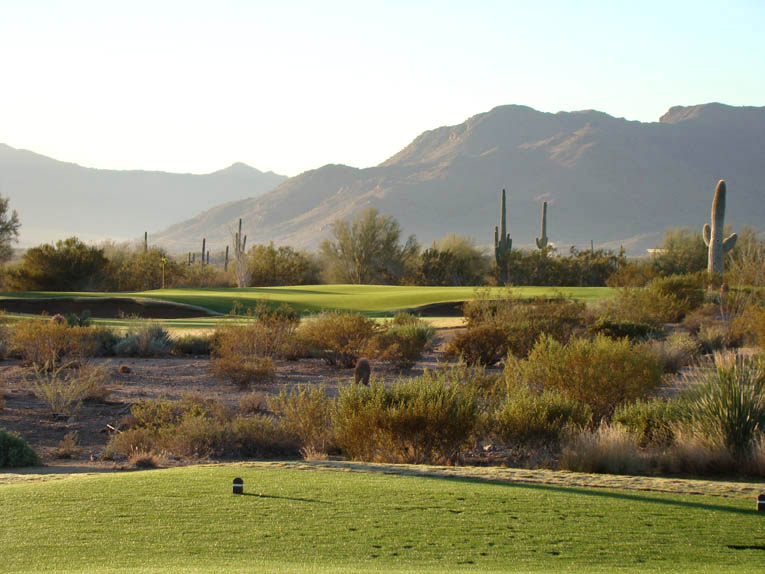
Many of the Saguaro greens feature broad slopes but the fifth hole is distinguished by its interior contours.
Sixth hole, 405 yards; Coore & Crenshaw’s gentle touch on the land is highlighted tee to green here by embracing the uphill nature of the hole by eschewing building up tee pads and by not making a cut in the far hill. At the bunkerless green site, the putting surface sits majestically at grade to its surrounds. Man-made contrivances are at a bare minimum and the hole’s quiet, natural appearance resonates composure.
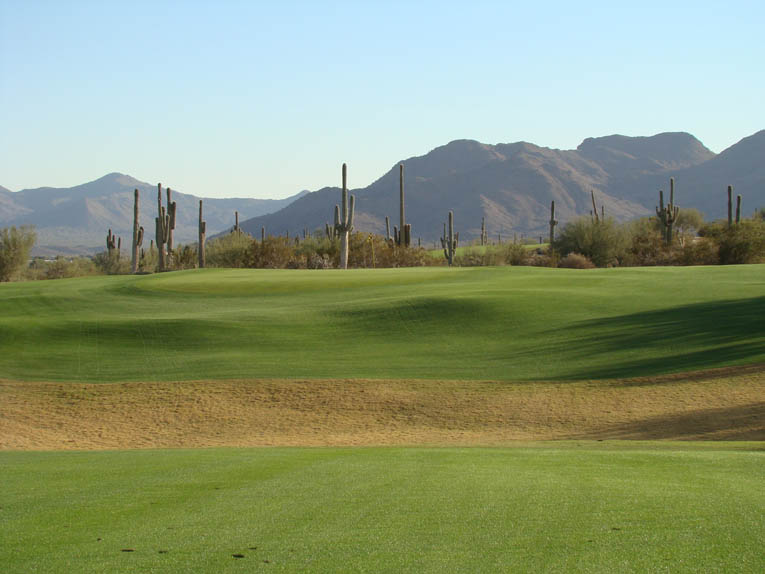
The Red Mountain serves as a distinctive backdrop for the approach at the sixth. It also has sacred significance for the Salt River Pima tribe that owns Coore & Crenshaw’s two other desert designs at Talking Stick. Coore is quick to acknowledge a Pinehurst influence for the abundance of short grass surrounding many of the greens.
Eighth hole, 500 yards; Visually striking, this reachable par five features some of the deepest bunkers on the course that nicely balance the reward of reaching the green in two with a risk of being ensnared by one of these pits and forced to pitch out sideways. Many consider it their favorite hole on the course which is a special compliment for Coore & Crenshaw because of the hole’s little known genesis: Prior to construction, the last third of the hole housed a water treatment facility for the reservation. A new, larger one several miles away was already built so Coore & Crenshaw knew that this land was at their disposal. Kudos to all that every trace of the industrial site has been eradicated with special credit reserved for Green Keeper Kreizenbeck and Francese for the manner in which they so faithfully restored the desert surrounds.
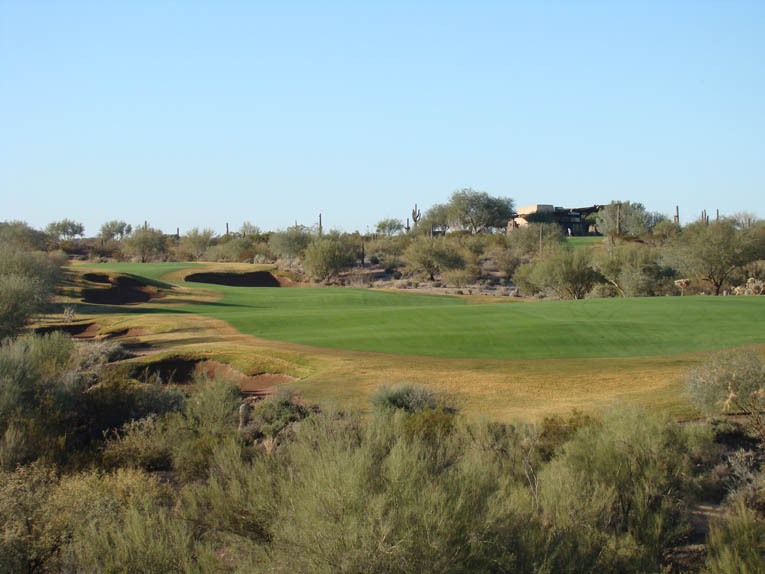
The early morning shadows provide insight as to the depth of the fairway bunkers that line the eighth fairway.
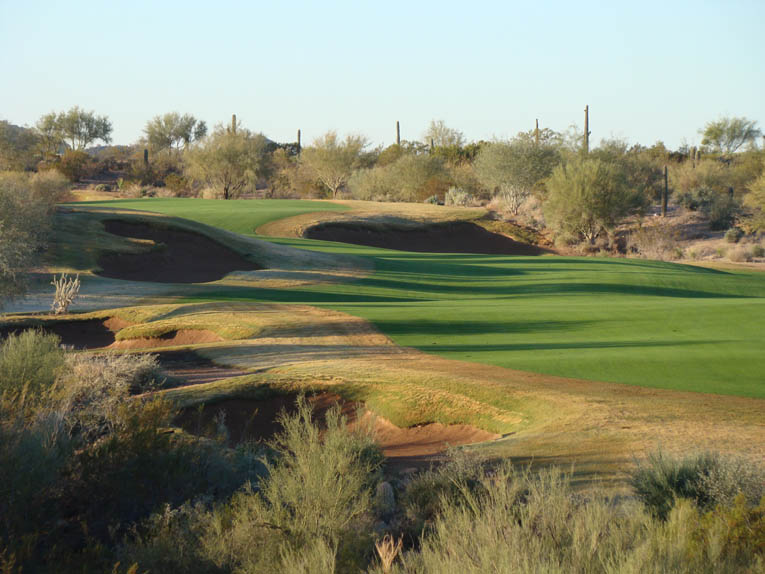
The large far right bunker is 125 yards from the green. It also serves as the aggressive target line off the tee for those hoping to reach this slight dogleg left green in two.
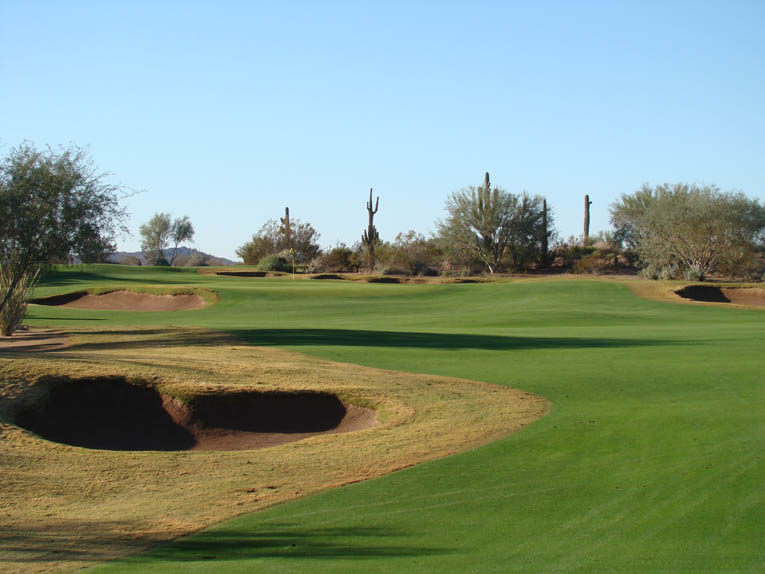
The eighth green complex is located in its own tranquil pocket on the property. Hard to believe it was once an industrial site!
Ninth hole, 130 yards; His personal favorite stretch on the course, Coore finds the seventh through the tenth particularly engaging because none of the four holes derive their playing characteristics from length. The short, level ninth appears to be straightforward but the narrow, deep kidney shaped green is a surprisingly elusive target, especially in a cross breeze. This sort of hole – one that appears simple but isn’t – is a favorite of Coore & Crenshaw. Other such examples include the thirteenth at Chechessee Creek and the twelfth at Friar’s Head. As the golfer attempts the tricky recovery shot(s) across the skinny ninth green his game may devolve into a sad form of ping-pong. Though not proven, Coore thinks it likely that more double bogeys occur here with a pushed-up green than at the fifteenth, a one shotter that measures 125 yards longer but whose green gathers balls in from one side.

Cross winds, the kidney shaped green that bends right around the far bunker above, and the narrowness of the putting surface help make the ninth a testy proposition.
Tenth hole, 320 yards; Coore & Crenshaw adhere to several design principles (width off the tee, angles of play, enjoyment for all level of players, varied green complexes which includes a focus on the area of fairway that leads onto the putting surface) throughout all their projects. They adapt these principles to each of the varied environs in which they agree to work, rarely ever repeating any particular feature. One exception is the boomerang green. Iterations can be found at Sand Hills, Chechessee Creek, and Colorado GC. The eighth at Sand Hills was the original and for many is still the best. If so, the tenth is a close second as it has it all: A long view from the elevated tee which allows the golfer to spot the day’s hole location on the inverted U-shaped green prior to teeing off, a fifty yard long bunker of great beauty on the inside of this slight dogleg, and the most treacherous green complex at We-Ko-Pa. Eating into the middle of the green is a narrow scar bunker that is a friend to neither man nor beast. The deepest greenside bunkers on the course are left and back of the two-tiered green and compound the perils of an imprecise pitch. Front hole locations are hard while the back ones are harder!

Each player in a group of four may choose a different club off the tee. Anything from a driver to a utility club may be appropriate depending on how frisky the golfer is feeling and the day’s hole location.
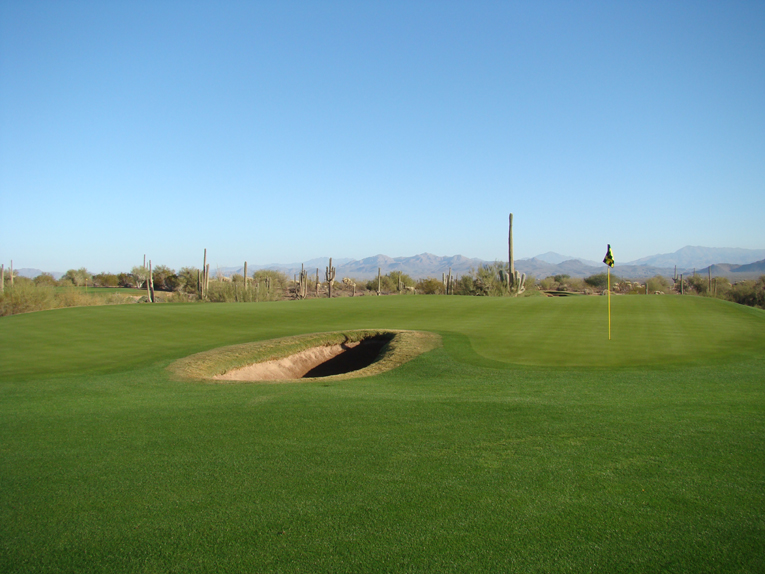
Not the biggest or deepest on the course, this bunker is nonetheless the nastiest because of the numerous awkward stances and lies that it routinely serves up. The green’s top tier is a scant 14 paces deep in spots with death over.
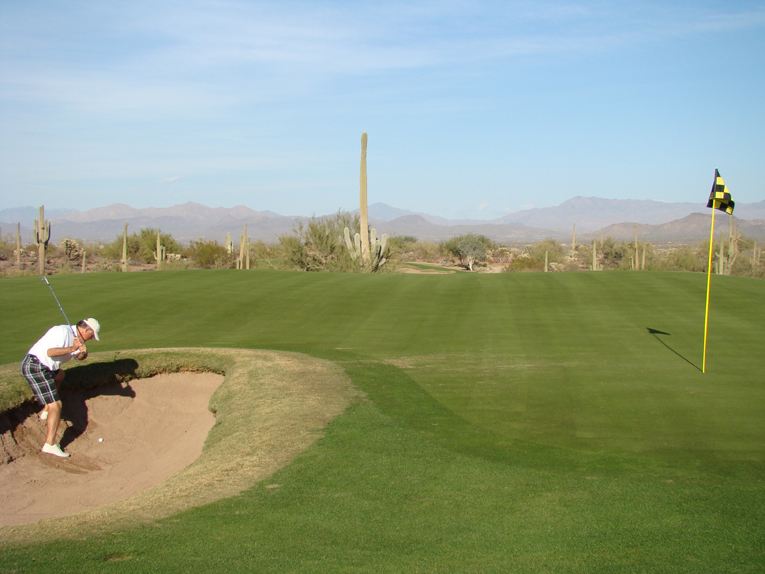
This golfer is but eight paces from the hole but has to aim well away because his backswing is compromised.
Eleventh hole, 195 yards; At the start of the project, Coore & Crenshaw appreciated that some visitors to this course might only play it once and be done. Of course, the hope was that the course would captivate and woo many a return round. How do you accomplish both objectives, make it fun for the first timer and yet withhold enough charms so as to entice repeat play?
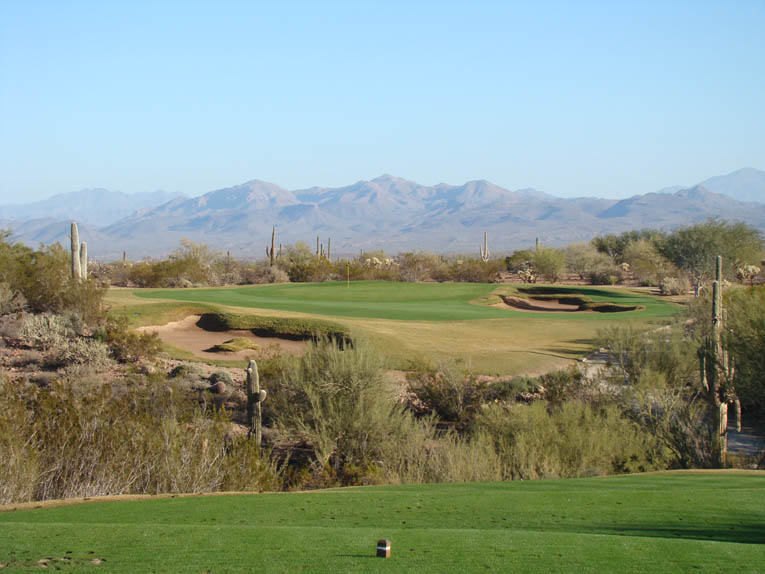
Tee balls hit into the front of green are guaranteed to be killed by the upslope while balls hit long left enjoy friendly kicks toward the putting surface. The golfer learns this only through trial and error.
Thirteenth hole, 455 yards; Flat fairways require some added spice and as they did at the fourth, Coore & Crenshaw supplied it here with another central bunker. The green looks innocuous but bends right around the lone greenside bunker creating some fascinating hole locations/playing angles. Though pancake flat, the thirteenth enjoys golfing qualities the equal of any hole on the course.

Look left and right at the desert floor and you gain an appreciation of how Coore & Crenshaw placed the fairway at grade to the desert floor.
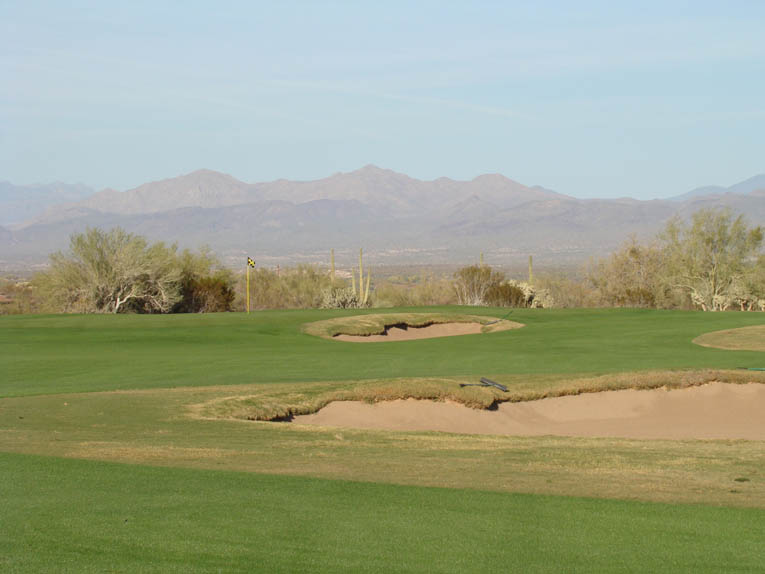
Note the clean lines around and behind the thirteenth green. The golfer is afforded yet another impressive long view.
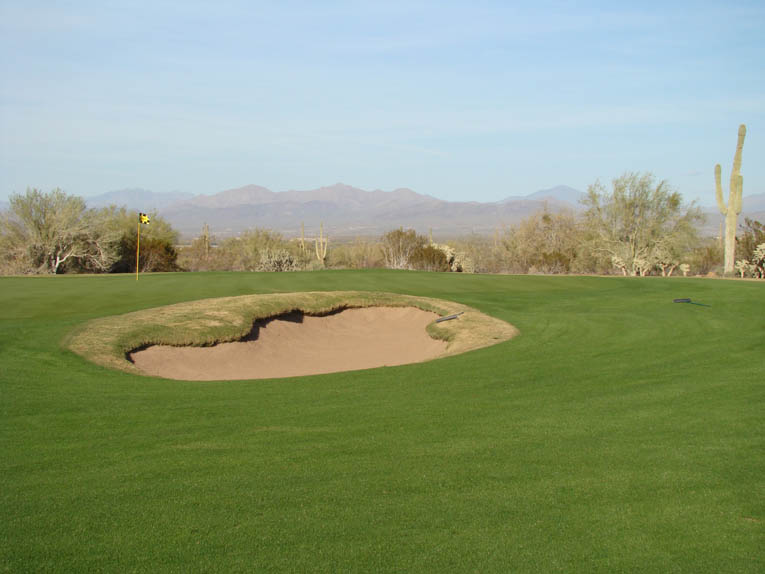
See the rake? It is not misplaced but was positioned there to highlight the slight mound that Ben Crenshaw concocted. The golfer can use this knob to kick his approach shot close to back right hole locations.
Fourteenth hole, 525 yards; Coore’s fondness for Red Lawrence’s 1962 Desert Forest design is well known. Located thirty minutes to the north in Carefree, its seventh hole features a split fairway that has captivated golfers for four (!) decades. Still, Coore has been slow to employ such a design feature because it rarely works. Here is a first rate exception. The left fairway was always apparent to Coore as it wrapped around a pretty wash but he kept looking at the land to the right of the wash and noticed that it was on a direct line to the green site. The route right definitely shortened the hole and so Coore & Crenshaw decided to employ an alternate fairway. Was it a smart decision? As Coore says, ‘If it is used, then it works and it was a good idea.’ His subsequent visits to the course have demonstrated proof: Plenty of divots in both fairways, which means that it is working just fine.
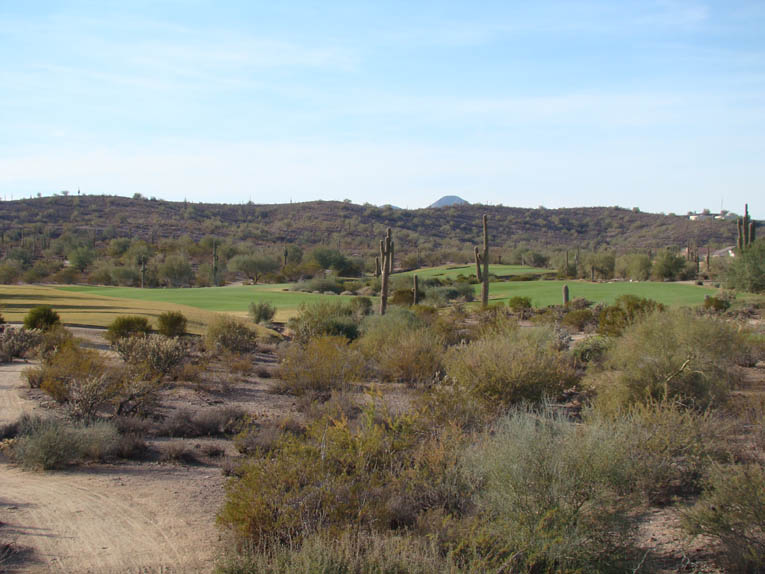
The primary left fairway runs uninterrupted to the green while the alternate fairway on the right presents the most direct but more dangerous path home. Prevailing wisdom is to play left unless you have the length to reach this uphill green in two.
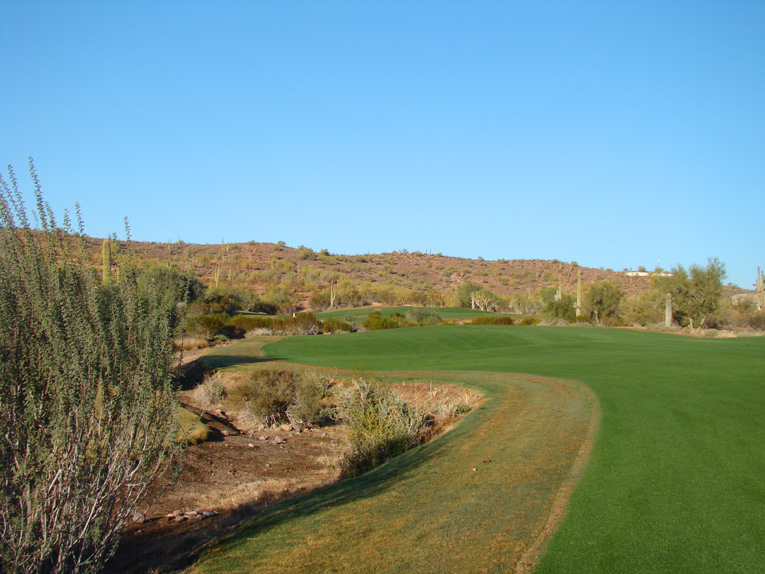
The left fairway is wider but precludes reaching the green in two. The right fairway seen above offers the best angle into the green but …
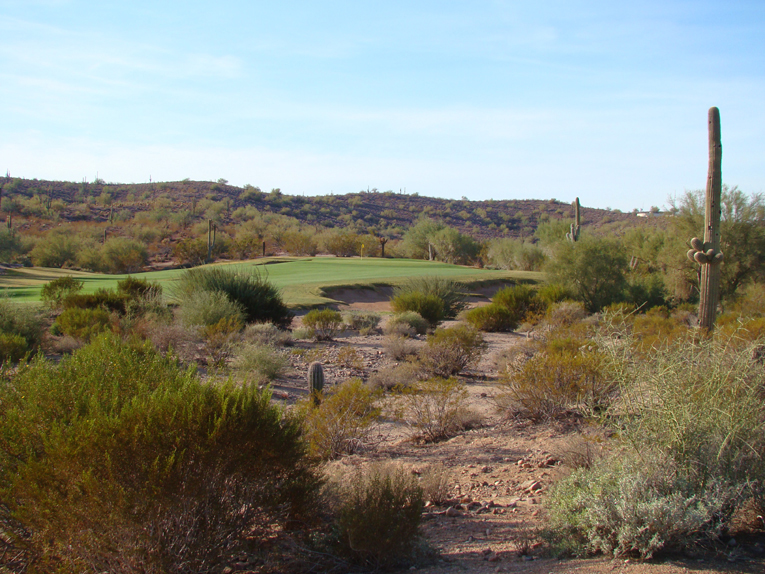
… the golfer has to carry this impressive array of disaster to reach the elevated green which is open from the right.

As seen from behind, the long broad sweep of the left fairway is evident above. So too is the fact that the right fairway provides the most direct route from tee to green.
Fifteenth hole, 235 yards; Some holes are great and a precious few great holes are regal. This one possesses such nobility. Most courses have elements (houses, trees, lack of topographic interest, etc.) that diminish the sense of scale and drama that its holes might otherwise enjoy. No such impediment exists here and the golfer basks in the glory of the sight – and challenge – before him. In many ways, the fifteenth is the opposite of the ninth as it plays easier than it looks. As such, it fits nicely into Alister MacKenzie’s concept of making a hole appear tough but play easy so that golfers gain a sense of playing satisfaction.
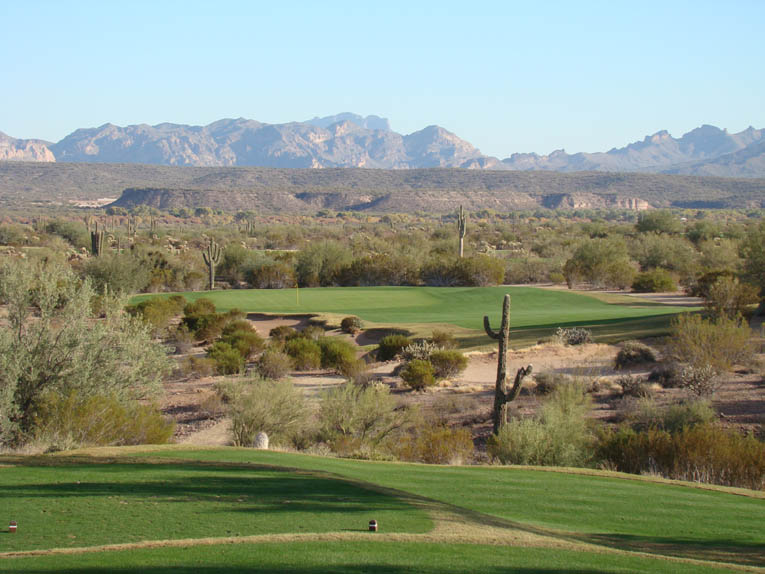
What a view from the fifteenth tee! The Superstition Mountains loom 15 to 30 miles in the distance. A ‘normal’ size green of some 6,000 to 7,000 square foot would woefully undermine the majestic scale of this setting.
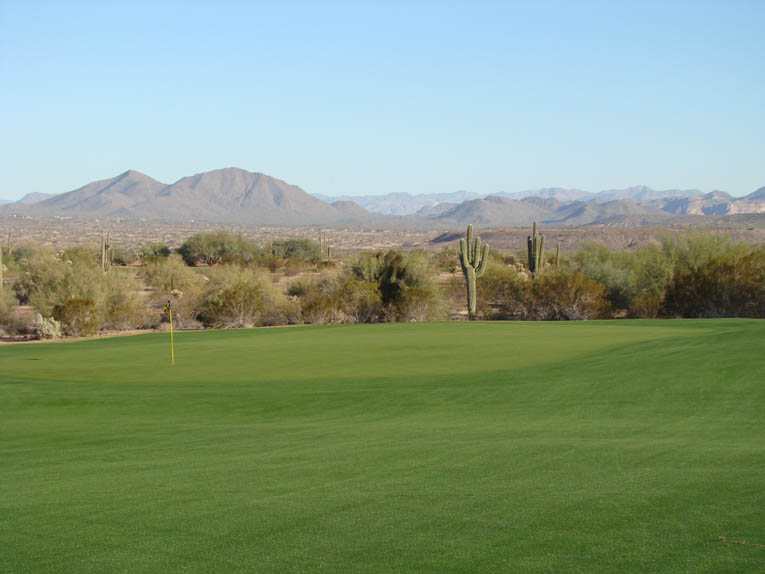
Instead Coore & Crenshaw built a grand 15,000 square foot beauty, complimented by a comparable sized area of short grass to its right.
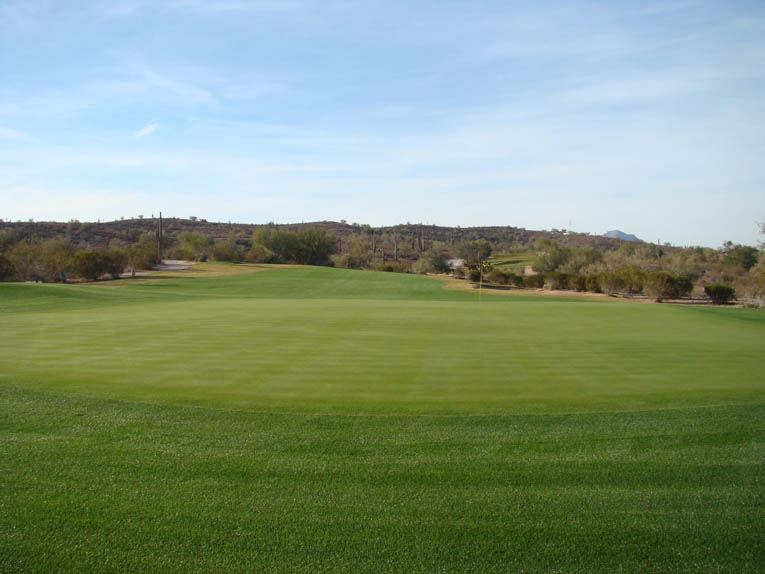
This view from behind the green is surprising as it shows how the last ~75% of the putting surface actually falls away toward the rear. Also note how the land right of the green (left as seen from behind) was massaged to feed balls onto the putting surface.
Sixteenth hole, 315 yards; One reason to understand golf course architecture is to know when to thrust and when to parry. A glimpse at the scorecard might suggest a birdie here but one look at this elevated green by anyone familiar with Coore & Crenshaw’s work is enough to dampen such grand hopes. One often finds with their work that the shorter the hole, the more vigilant the golfer must be!

Staying down the right has its advantage as the left half of the fairway shunts tee balls even farther left …
Seventeenth hole, 370 yards; The benefits of routing a hole cross drainage are rarely more evident than here. Bomb away if you wish but beware that a tee ball positioned in the 100 yard vicinity is likely to leave the golfer with an awkward, hanging downhill stance. Potentially worse, get it all the way to the bottom of the hill and enjoy a short flip to the green whose surface is now hidden from view. Though the landforms are less severe here, the golfer might be reminded of the tenth at Shinnecock Hills where golfers have debated for decades as to how best play the hole. Holes that are built up and down drainage generally play in a more straightforward manner and lack such conundrums.
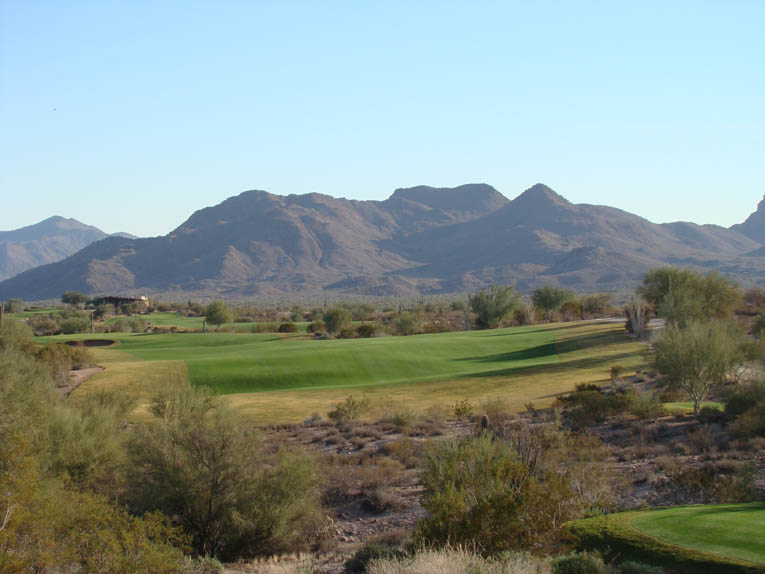
A fine plateau is offered 100 to 130 yards from the green. Anything closer and the golfer is likely to suffer either an awkward downhill stance or a poor view of the flag or both.
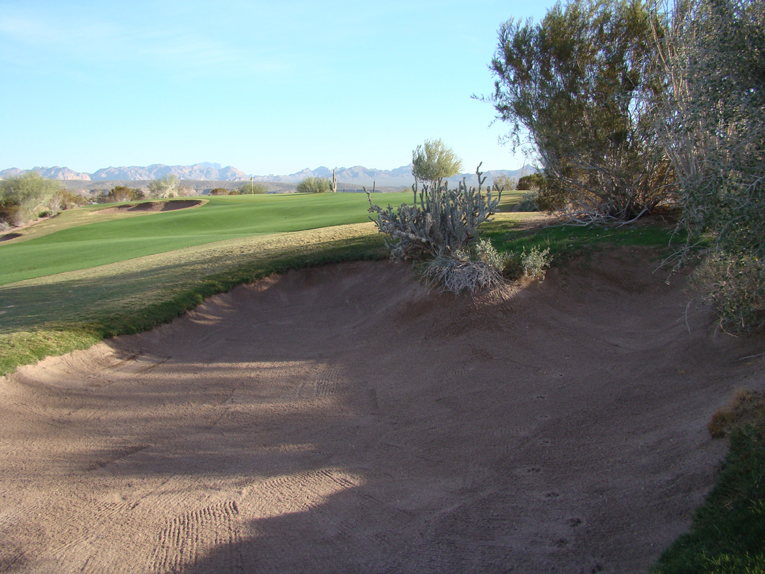
As demonstrated in this bunker to the right of the seventeenth fairway, coyotes are notoriously ill-mannered for raking behind themselves!
Eighteenth hole, 490 yards; Having played only one par five on the back nine, the golfer making the short walk from the seventeenth green down to the tee expects that this is the second completing the classic 36-36 par 72 course. The only problem? This big sprawling hole is a par four and little sympathy is afforded the golfer who has a brief pity party for himself on the tee. Far from the dreary slog of many long two shot finishers, this hole is set over some of the most exhilarating golf land on the property. What a way to conclude the day: Carry the valley and the narliest bunker on the course to reach the distant fairway and find that an equally attractive approach shot awaits.
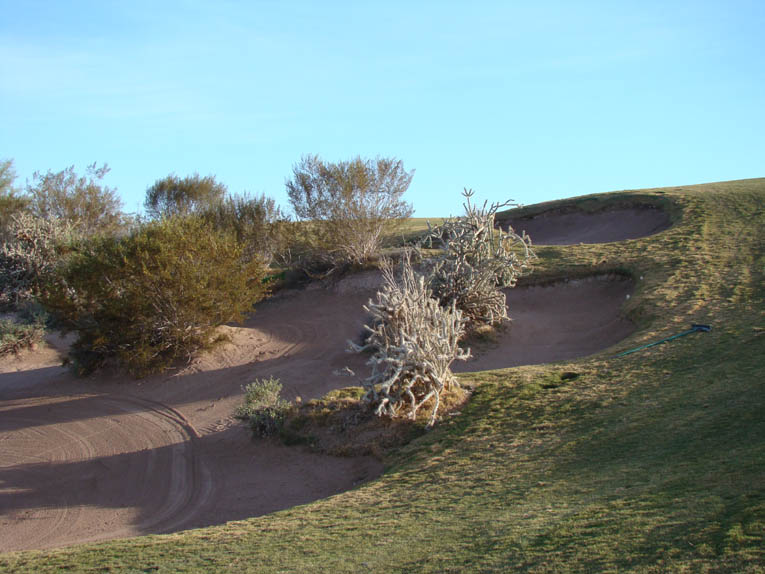
… the course’s deepest bunker replete with bur sage, stag thorn Cholla, and creosote and enjoy the perfect angle into the eighteenth green.

Shy safely to the right off the tee and face this long approach shot over a string of bunkers to a green set obliquely to the right side of the fairway.
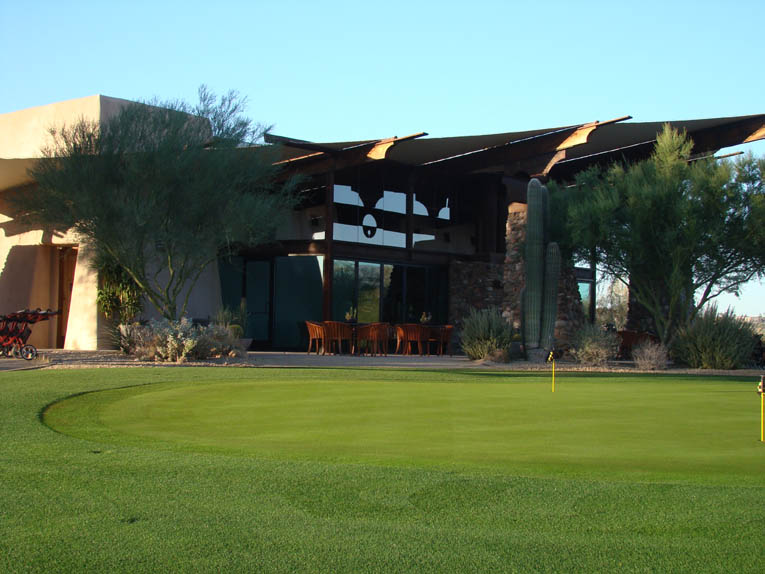
The contemporary Southwestern edifice left of the eighteenth green provides a clear sense as to region of the world within which We-Ko-Pa Golf Club is located.
One benefit of giving Coore so much land is that it all but guarantees that there will be no mutts among his eighteen holes. Coore dreads a poor hole as he is convinced that a course is only as good as its weakest link. A stinker jammed into a corner of the property can undermine/overshadow the worth of the other seventeen holes in his eyes. The Saguaro Course at We-Ko-Pa has no such weak links. Some holes are more equal than others as with all courses but all the holes across this spacious property have something to offer.
Doing his best imitation of the modest Harry Colt, Bill Coore says, “We try to build good golf courses, and this is one of them.” That’s an interesting comment coming from a principal behind the world class designs like Sand Hills, Friar’s Head, Bandon Trails, Old Sandwich, Lost Farms, and Shanqin Bay. Where the Saguaro Course fits within this impressive book of business is hard to say. After all, playing golf in Arizona on fields of irrigated turf abutting the gnarly desert under bright blue skies will never be confused with golf on firm fescue grasses next to the sea and its capricious winds. It’s just different and that helps make golf the best of all sports. If the essence of the Saguaro Course – a walk in the beautiful Sonoran desert unmarred by man-made structures on a spacious Coore & Crenshaw course full of strategy – doesn’t sound compelling, a different pastime may be in order. To take this course for granted as ‘just’ another in a long line of great courses is to both under appreciate and devalue what was accomplished here.
The End


